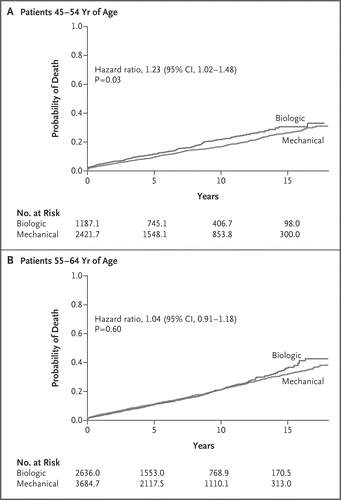当前位置:
X-MOL 学术
›
N. Engl. J. Med.
›
论文详情
Our official English website, www.x-mol.net, welcomes your feedback! (Note: you will need to create a separate account there.)
Mechanical or Biologic Prostheses for Aortic-Valve and Mitral-Valve Replacement.
The New England Journal of Medicine ( IF 158.5 ) Pub Date : 2017-11-09 , DOI: 10.1056/nejmoa1613792 Andrew B Goldstone 1 , Peter Chiu 1 , Michael Baiocchi 1 , Bharathi Lingala 1 , William L Patrick 1 , Michael P Fischbein 1 , Y Joseph Woo 1
The New England Journal of Medicine ( IF 158.5 ) Pub Date : 2017-11-09 , DOI: 10.1056/nejmoa1613792 Andrew B Goldstone 1 , Peter Chiu 1 , Michael Baiocchi 1 , Bharathi Lingala 1 , William L Patrick 1 , Michael P Fischbein 1 , Y Joseph Woo 1
Affiliation

|
BACKGROUND
In patients undergoing aortic-valve or mitral-valve replacement, either a mechanical or biologic prosthesis is used. Biologic prostheses have been increasingly favored despite limited evidence supporting this practice.
METHODS
We compared long-term mortality and rates of reoperation, stroke, and bleeding between inverse-probability-weighted cohorts of patients who underwent primary aortic-valve replacement or mitral-valve replacement with a mechanical or biologic prosthesis in California in the period from 1996 through 2013. Patients were stratified into different age groups on the basis of valve position (aortic vs. mitral valve).
RESULTS
From 1996 through 2013, the use of biologic prostheses increased substantially for aortic-valve and mitral-valve replacement, from 11.5% to 51.6% for aortic-valve replacement and from 16.8% to 53.7% for mitral-valve replacement. Among patients who underwent aortic-valve replacement, receipt of a biologic prosthesis was associated with significantly higher 15-year mortality than receipt of a mechanical prosthesis among patients 45 to 54 years of age (30.6% vs. 26.4% at 15 years; hazard ratio, 1.23; 95% confidence interval [CI], 1.02 to 1.48; P=0.03) but not among patients 55 to 64 years of age. Among patients who underwent mitral-valve replacement, receipt of a biologic prosthesis was associated with significantly higher mortality than receipt of a mechanical prosthesis among patients 40 to 49 years of age (44.1% vs. 27.1%; hazard ratio, 1.88; 95% CI, 1.35 to 2.63; P<0.001) and among those 50 to 69 years of age (50.0% vs. 45.3%; hazard ratio, 1.16; 95% CI, 1.04 to 1.30; P=0.01). The incidence of reoperation was significantly higher among recipients of a biologic prosthesis than among recipients of a mechanical prosthesis. Patients who received mechanical valves had a higher cumulative incidence of bleeding and, in some age groups, stroke than did recipients of a biologic prosthesis.
CONCLUSIONS
The long-term mortality benefit that was associated with a mechanical prosthesis, as compared with a biologic prosthesis, persisted until 70 years of age among patients undergoing mitral-valve replacement and until 55 years of age among those undergoing aortic-valve replacement. (Funded by the National Institutes of Health and the Agency for Healthcare Research and Quality.).
中文翻译:

用于主动脉瓣和二尖瓣置换的机械或生物假体。
背景在接受主动脉瓣或二尖瓣置换术的患者中,使用机械或生物假体。尽管支持这种做法的证据有限,但生物假体越来越受到青睐。方法 我们比较了自 1996 年以来在加利福尼亚接受初次主动脉瓣置换术或使用机械或生物假体进行二尖瓣置换术的患者的逆概率加权队列的长期死亡率和再次手术、卒中和出血率到 2013 年。根据瓣膜位置(主动脉瓣与二尖瓣)将患者分为不同的年龄组。结果 从 1996 年到 2013 年,生物瓣膜在主动脉瓣和二尖瓣置换术中的使用大幅增加,主动脉瓣置换术从 11.5% 增加到 51.6%,从 16.8% 增加到 53。7% 用于二尖瓣置换术。在接受主动脉瓣置换术的患者中,在 45 至 54 岁的患者中,接受生物瓣膜的 15 年死亡率显着高于接受机械瓣膜的患者(15 年时分别为 30.6% 和 26.4%;风险比, 1.23;95% 置信区间 [CI],1.02 至 1.48;P=0.03),但在 55 至 64 岁的患者中没有。在接受二尖瓣置换术的患者中,接受生物假体的死亡率显着高于接受机械假体的 40 至 49 岁患者(44.1% 对 27.1%;风险比,1.88;95% CI) , 1.35 至 2.63;P<0.001)和 50 至 69 岁的人群(50.0% 与 45.3%;风险比,1.16;95% CI,1.04 至 1.30;P=0.01)。生物假体接受者的再次手术发生率明显高于机械假体接受者。接受机械瓣膜的患者比接受生物瓣膜的患者有更高的出血累积发生率,并且在某些年龄组中,中风的累积发生率更高。结论 与生物瓣膜相比,机械瓣膜相关的长期死亡率获益在接受二尖瓣置换术的患者中持续至 70 岁,在接受主动脉瓣置换术的患者中持续至 55 岁。(由美国国立卫生研究院和医疗保健研究与质量局资助。)。接受机械瓣膜的患者比接受生物瓣膜的患者有更高的出血累积发生率,并且在某些年龄组中,中风的累积发生率更高。结论 与生物瓣膜相比,机械瓣膜相关的长期死亡率获益在接受二尖瓣置换术的患者中持续至 70 岁,在接受主动脉瓣置换术的患者中持续至 55 岁。(由美国国立卫生研究院和医疗保健研究与质量局资助。)。接受机械瓣膜的患者比接受生物瓣膜的患者有更高的出血累积发生率,并且在某些年龄组中,中风的累积发生率更高。结论 与生物瓣膜相比,机械瓣膜相关的长期死亡率获益在接受二尖瓣置换术的患者中持续至 70 岁,在接受主动脉瓣置换术的患者中持续至 55 岁。(由美国国立卫生研究院和医疗保健研究与质量局资助。)。在接受二尖瓣置换术的患者中持续到 70 岁,在接受主动脉瓣置换术的患者中持续到 55 岁。(由美国国立卫生研究院和医疗保健研究与质量局资助。)。在接受二尖瓣置换术的患者中持续到 70 岁,在接受主动脉瓣置换术的患者中持续到 55 岁。(由美国国立卫生研究院和医疗保健研究与质量局资助。)。
更新日期:2017-11-09
中文翻译:

用于主动脉瓣和二尖瓣置换的机械或生物假体。
背景在接受主动脉瓣或二尖瓣置换术的患者中,使用机械或生物假体。尽管支持这种做法的证据有限,但生物假体越来越受到青睐。方法 我们比较了自 1996 年以来在加利福尼亚接受初次主动脉瓣置换术或使用机械或生物假体进行二尖瓣置换术的患者的逆概率加权队列的长期死亡率和再次手术、卒中和出血率到 2013 年。根据瓣膜位置(主动脉瓣与二尖瓣)将患者分为不同的年龄组。结果 从 1996 年到 2013 年,生物瓣膜在主动脉瓣和二尖瓣置换术中的使用大幅增加,主动脉瓣置换术从 11.5% 增加到 51.6%,从 16.8% 增加到 53。7% 用于二尖瓣置换术。在接受主动脉瓣置换术的患者中,在 45 至 54 岁的患者中,接受生物瓣膜的 15 年死亡率显着高于接受机械瓣膜的患者(15 年时分别为 30.6% 和 26.4%;风险比, 1.23;95% 置信区间 [CI],1.02 至 1.48;P=0.03),但在 55 至 64 岁的患者中没有。在接受二尖瓣置换术的患者中,接受生物假体的死亡率显着高于接受机械假体的 40 至 49 岁患者(44.1% 对 27.1%;风险比,1.88;95% CI) , 1.35 至 2.63;P<0.001)和 50 至 69 岁的人群(50.0% 与 45.3%;风险比,1.16;95% CI,1.04 至 1.30;P=0.01)。生物假体接受者的再次手术发生率明显高于机械假体接受者。接受机械瓣膜的患者比接受生物瓣膜的患者有更高的出血累积发生率,并且在某些年龄组中,中风的累积发生率更高。结论 与生物瓣膜相比,机械瓣膜相关的长期死亡率获益在接受二尖瓣置换术的患者中持续至 70 岁,在接受主动脉瓣置换术的患者中持续至 55 岁。(由美国国立卫生研究院和医疗保健研究与质量局资助。)。接受机械瓣膜的患者比接受生物瓣膜的患者有更高的出血累积发生率,并且在某些年龄组中,中风的累积发生率更高。结论 与生物瓣膜相比,机械瓣膜相关的长期死亡率获益在接受二尖瓣置换术的患者中持续至 70 岁,在接受主动脉瓣置换术的患者中持续至 55 岁。(由美国国立卫生研究院和医疗保健研究与质量局资助。)。接受机械瓣膜的患者比接受生物瓣膜的患者有更高的出血累积发生率,并且在某些年龄组中,中风的累积发生率更高。结论 与生物瓣膜相比,机械瓣膜相关的长期死亡率获益在接受二尖瓣置换术的患者中持续至 70 岁,在接受主动脉瓣置换术的患者中持续至 55 岁。(由美国国立卫生研究院和医疗保健研究与质量局资助。)。在接受二尖瓣置换术的患者中持续到 70 岁,在接受主动脉瓣置换术的患者中持续到 55 岁。(由美国国立卫生研究院和医疗保健研究与质量局资助。)。在接受二尖瓣置换术的患者中持续到 70 岁,在接受主动脉瓣置换术的患者中持续到 55 岁。(由美国国立卫生研究院和医疗保健研究与质量局资助。)。


























 京公网安备 11010802027423号
京公网安备 11010802027423号